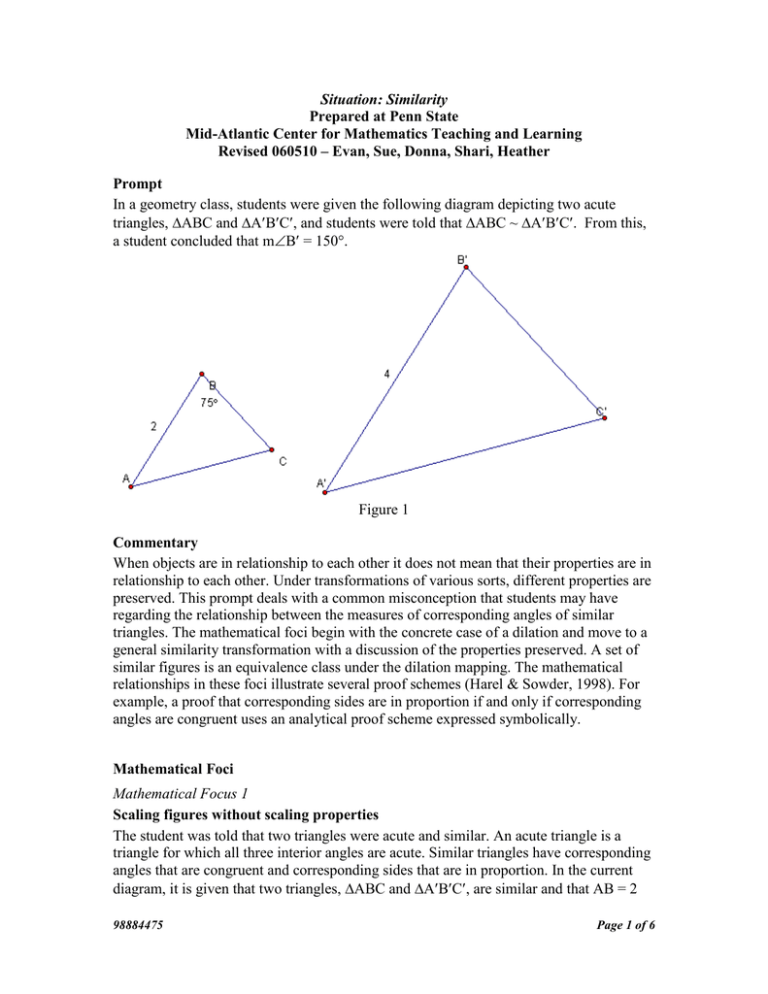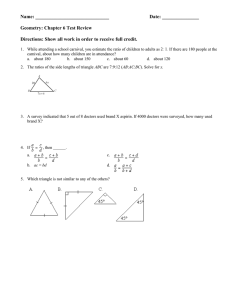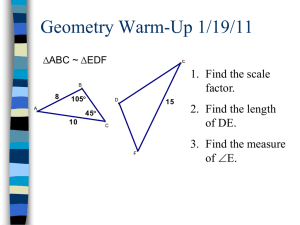Situation: Similarity Prepared at Penn State
advertisement

Situation: Similarity Prepared at Penn State Mid-Atlantic Center for Mathematics Teaching and Learning Revised 060510 – Evan, Sue, Donna, Shari, Heather Prompt In a geometry class, students were given the following diagram depicting two acute triangles, ABC and ABC, and students were told that ABC ~ ABC. From this, a student concluded that mB = 150°. Figure 1 Commentary When objects are in relationship to each other it does not mean that their properties are in relationship to each other. Under transformations of various sorts, different properties are preserved. This prompt deals with a common misconception that students may have regarding the relationship between the measures of corresponding angles of similar triangles. The mathematical foci begin with the concrete case of a dilation and move to a general similarity transformation with a discussion of the properties preserved. A set of similar figures is an equivalence class under the dilation mapping. The mathematical relationships in these foci illustrate several proof schemes (Harel & Sowder, 1998). For example, a proof that corresponding sides are in proportion if and only if corresponding angles are congruent uses an analytical proof scheme expressed symbolically. Mathematical Foci Mathematical Focus 1 Scaling figures without scaling properties The student was told that two triangles were acute and similar. An acute triangle is a triangle for which all three interior angles are acute. Similar triangles have corresponding angles that are congruent and corresponding sides that are in proportion. In the current diagram, it is given that two triangles, ABC and ABC, are similar and that AB = 2 98884475 Page 1 of 6 and AB = 4. A ratio (as quantity) describing the multiplicative relationship between sides AB and AB can be identified and used to determine the relative lengths of the unknown sides of ABC as scaled sides of ABC or vice versa. In particular, since AB = 2AB and ABC and ABC are similar, it must be true that AC = 2AC, and BC = 2BC. While the scalar, 2, can be used to find relative lengths of corresponding sides of these similar triangles, it does not apply to the measures of the angles. The student correctly identified the constant of proportionality, 2, but incorrectly applied proportionality to a pair of corresponding angles from the two triangles. There are two ways to consider how the students’ reasoning becomes problematic. First, the sum of the measures of the angles of ABC is 180°. If the student’s rule extended to doubling the measure of all angles in ABC, the sum of the measures of the angles of ABC would be doubled, or 360°, and ABC would not be a triangle. Second, the given information states that the original triangles were both acute, but if mB = 150°, ABC is an obtuse triangle. A dynamic model of similar triangles, such as: http://argyll.epsb.ca/jreed/math9/strand3/3201.htm demonstrates the effect of maintaining proportionality of sides in two similar triangles. Mathematical Focus 2 Similarity transformation If we were to consider plotting ∆ABC on a Cartesian plane, we could consider ∆ ABC to be the image of a similarity transformation of ∆ABC. A similarity transformation of a Euclidean space is a function from the space into itself that multiplies all distances by the same scalar (Wikipedia, 2005). Thus, we can consider similarity transformations to be mappings of the form F(x, y) = (kx, ky) for some k ≠ 0, which in this case would map ∆ABC to the similar triangle, ∆ABC, with a scale factor of 2. The image triangle, ∆ABC, is the image of a dilation centered at the origin. For this similarity transformation, while sides of ∆ABC are double the length of the corresponding sides in ∆ABC, the angles of ∆ABC are congruent to the corresponding angles of ∆ABC. In general, if |k| < 1, the mapping results in a contraction centered at the origin, for which the resulting image is smaller than its pre-image. If |k| > 1, the mapping results in a dilation centered at the origin, for which the resulting image is larger than its pre-image. If k = 1, the mapping results in the identity transformation, for which the resulting image is the same size as its pre-image (Calkins, 2005). More generally, we can consider a similarity transformation as a function, f, from the space into itself that multiplies all distances by the same positive scalar, r. For any two points x and y where d(x,y) is the Euclidean distance from x to y, d( f (x), f (y)) r d(x, y) . The figures resulting from two sets of points are similar if one is the image of the other (Wikipedia, 2005) under a similarity transformation. Transformations in which shape and size are preserved are known as isometries. There are five types of isometries: identity, reflection, rotation, translation, and glide reflection. Transformations in which shape is preserved but size is not necessarily preserved are similarity transformations. Mathematical Focus 3 Preservation of properties under similarity 98884475 Page 2 of 6 In general, some properties of geometric objects are preserved under similarity. In this case the student did not realize that measures of corresponding angles of similar triangles are preserved. Additionally, ratios of pairs of corresponding sides are preserved. The ratio of the perimeter to a side of one triangle is the same as the ratio of the perimeter to the corresponding side of a similar triangle. As a result, shape is preserved; perimeter maintains the same constant of proportionality as the sides; and the constant of proportionality of the area is the square of the constant of proportionality of the sides. More generally, for similar polygons, corresponding angles are congruent, and corresponding sides are proportional. Thus, shape is preserved; the proportionality constant for the perimeters is the same proportionality constant as that for the sides; and the proportionality constant for the area is the square of the proportionality constant for the sides. Some related property preservation results are: For similar three-dimensional objects, the proportionality constant for surface area is the square of the proportionality constant for the edges, but the proportionality constant of the volume is the cube of the proportionality constant for the edges. Additionally, congruence is a special case of similarity, in which properties such as shape, side length, perimeter, and area are preserved. Mathematical Focus 4 Relationship between the inscribed angle and the intercepted arc Using GSP, a dynamic diagram can be created to illustrate that shape and angle measure are preserved for similar triangles. A triangle is inscribed in a circle centered at the origin using polar coordinates. The coordinates of any point on the circle are given (r, ), where r is the radius of the circle and is the measure of the angle in radians. Because the triangle is inscribed in a circle, dilating the circle produces similar triangles. For any angle in the triangle, the measure of the angle is equal to the arc length divided by the radius and this quotient is constant. The preceding sentence says that angle measure is a function of arc length and radius, namely, m(a,r)= a/r. That suggests that angle measure is dependent on the radius. Since arc length divided by radius is a constant, the angle measure does not change as the radius changes, but angle measure still is a (constant) function of the radius. 98884475 Page 3 of 6 QuickTime™ and a TIFF (Uncompressed) decompressor are needed to see this picture. Mathematical Focus 5 Triangles have congruent corresponding angles if and only if the ratios of the corresponding sides are in proportion By definition, similar triangles have corresponding angles that are congruent and corresponding sides that are in proportion. In general, given two triangles, ABC and AB BC AC DEF, A D, B E, and C F if and only if . (Much of the DE EF DF following work is from Ohio University Mathematics Department, 2005.) First, assume A D, B E, and C F for ABC and DEF. Then construct points G and uuur uuur H on rays AB and AC such that AG = DE and AH = DF. By the SAS theorem of congruence, AGH DEF, and AGH E, since AGH and E are corresponding parts of congruent triangles. We are given thatE B, so by transitivity, AGH B. suur suur Since AGH and B are corresponding angles and congruent, GH || BC . If we were to suur uuur uuur construct a line L through point A parallel to line BC , then AB and AC are transversals suur suur of parallel lines L, GH , and BC . Since parallel lines divide transversals proportionally, AB AG AB AC , which can be rewritten as . Since AG = DE and AH = DF, by AC AH AG AH AB AC BC AB substitution, . We could repeat this same process to show that . By DE DF EF DE BC AC AB BC AC transitivity then, . Thus, . EF AH DE EF DF 98884475 Page 4 of 6 Figure 2 AB BC AC for ABC and DEF. If these ratios are equal to 1, the DE EF DF two triangles are congruent, and A D, B E, and C F since each is a pair of corresponding angles, which are congruent in congruent triangles. Assume the ratio is greater than 1. (If the ratio is not greater than 1, interchange the labels of the two AB such that AG = DE. Let L be triangles to make it true.) Let G be a point suuon r segment a line containing G that is parallel to line BC . (If we are given a line and a point not on the line, then there exists a unique line through the given point parallel to the given line.) suur suur suur suur Because line AC intersects line BC and line BC is parallel to line L, AC must intersect L. Call this point of intersection H. Then, corresponding angles ABC and AGH are congruent. (Also, ACB and AHG are congruent.) By reflexivity,A A. By AA AB AG Similarity, ABC~AGH, and corresponding sides are in proportion. So, and BC GH BC GH AB BC CA AB BC AC (since ). We are given that , which can be CA HA AG GH HA DE EF DF AB BC BC AC rewritten as two equations, and . These equations can be rewritten DE EF EF DF AB DE BC EF as and . Combining with the information using the corresponding BC EF AC DF AG DE GH EF sides of the triangles, we have and , which can be rearranged as GH EF HA FD AG GH GH .EF and HA .FD . Substituting AG = DE, and GH = EF, we get DE EF DE EF GH .EF EF and HA .FD FD . Using SSS congruence, we have DE EF AGH~DEF. Thus, AD, AGHE, and AHG F as corresponding angles of congruent triangles. SinceB AGH, B E by transitivity, and sinceC AHG, C F by transitivity. Thus, A D, B E, and C F . Next, assume 98884475 Page 5 of 6 Figure 3 References Calkins, K. G., 2005. Same Shape but maybe not same Size: Similarity. Retrieved Aug. 2, 2005 from http://www.andrews.edu/~calkins/math/webtexts/geom12.htm Harel, G. & Sowder, L. (1998). Students’ proof schemes: Results from exploratory studies. In A. H. Schoenfeld, J. Kaput, & E. Dubinsky (Eds.), CBMS Issues in Mathematics Education (Vol. 7, pp. 234-283). Providence, RI: American Mathematical Society. Ohio University Mathematics Department. (2005). Spring 2005 Math 330B Lab 1 Solutions. Retrieved August 17, 2005, from http://www.math.ohiou.edu/courses/math330B/Lab%201/Math%20330B%20Lab %201%20Solutions_HTML.htm Reed, J. 2000. Shape and Space. Retrieved Aug. 2, 2005 from http://argyll.epsb.ca/jreed/math9/strand3/3201.htm Wikipedia, the free encyclopedia, 2005. Retrieved Aug. 2, 2005 from http://en.wikipedia.org/wiki/Similarity_transformation END OF VIGNETTE DISCUSSION – END OF VIGNETTE DISCUSSION 98884475 Page 6 of 6


